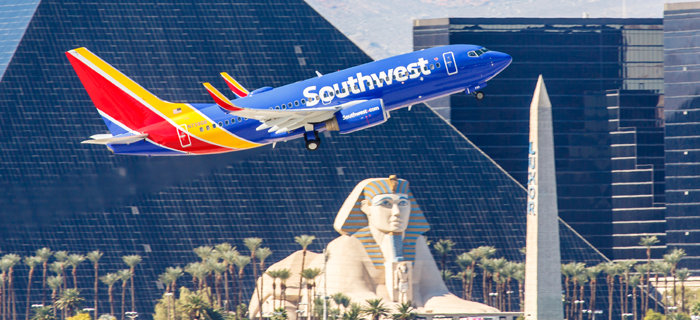A New Study Proves That the “Southwest Effect” Is Actually A Real Thing

Have you heard of the “Southwest Effect” in the air travel industry? It’s a phenomenon where airports that are a major hub for Southwest Airlines end up having cheaper fares on average overall. And now there’s a study to back up the theory, proving that the Southwest Effect is actually a real thing.
Midway Airport in Chicago has a leg up on the competition—in a study of average airfares from 50 airports across the country, Midway comes in at the second cheapest, only losing out to Oakland International Airport in California. Midway’s average fare, including taxes, comes out to $172.52. O’Hare, by contrast, averages at $204.54, and the most expensive—Honolulu—averages at $290.15.
The remaining 10 cheapest airports, according to the study and reported by Chicago Business Journal, are “Ft. Lauderdale International Airport, ($173.00), followed by Las Vegas’ McCarran International Airport ($174.34), Orlando International Airport ($175.76), San Jose (California) International Airport ($177.63), Dallas Love Field ($177.85), Denver International Airport ($180.78), Baltimore Washington International Airport ($186.21), [and] Tampa International Airport ($187.37).”
There’s one common thread with the cheapest airports: the Southwest Effect. Each airport is a hub for Southwest Airlines, which appears to drive down the average cost of airfare at whatever airport hosts the airline. It makes sense—Southwest flies for cheaper and doesn’t charge bag fees or rebooking or cancellation penalties.
Another interesting finding from the report? United Airlines appears to be driving average costs up. Four of the top 10 most expensive airports are major United hubs: San Francisco, Newark, Houston, and Washington Dulles.























While the SW Effect may be real, i'd wager it's diminishing as they are no longer the low cost airline. I wish i'd bought stock about 20 years ago....
Southwest has not been a low-cost airline for at least a few years. For example, their fares from the Bay Area to Southern California airports are very much higher than the narrow line like jet blue. Last month we wanted to fly to Orange county from Oakland. The two of us saved over $180, in total, ticketing costs by taking JetBlue to Long Beach and spend the extra 20 minutes and pay Uber an extra $20. Even United
The mention of Hawaii as the most expensive airport makes it very clear that there is no control for flight length. I'd bet money that there also isn't a control for service class. Maybe the "Southwest Effect" as measured by the study is purely a function of Southwest not having biz or first class fares. Certainly biz and first class fares drive up average ticket prices considerably for the airlines that offer them as can be seen by their impact on those airlines' bottom lines. As for price: in my experience as a business traveller, I have flown on a Southwest ticket that was significantly cheaper than alternatives. Those fares exist, but they seem to be primarily snapped up by leisure travelers or people traveling known routes frequently.
@LovingmyRaffles I actually live in New York and tbh that hasn't been my experience, I find UA from newark to be comparable to DL and AA from JFK and LGA. That said, the plural of Anecdotes isn't Statistics, so I'd have to look further into the actual fares from these airports. and @Ca77andra, I didn't look too far into it, though I think a way to control for what I mentioned would be to compare RASM on US domestic routes, perhaps?
United is unique among the majors in having fortress hubs in major O&D markets. (AA & DL share JFK with B6, but EWR is separate; in WAS, AA & DL also share DCA, with IAD separate; DFW & DAL compete for domestic feed; LAX is an open city; ORD is split between UA & AA, with MDW/WN; MIA & FLL compete for domestic too) Perhaps that's why its hubs have higher average costs - the natural effect of a dominant (quasi-monopolistic) market leader?